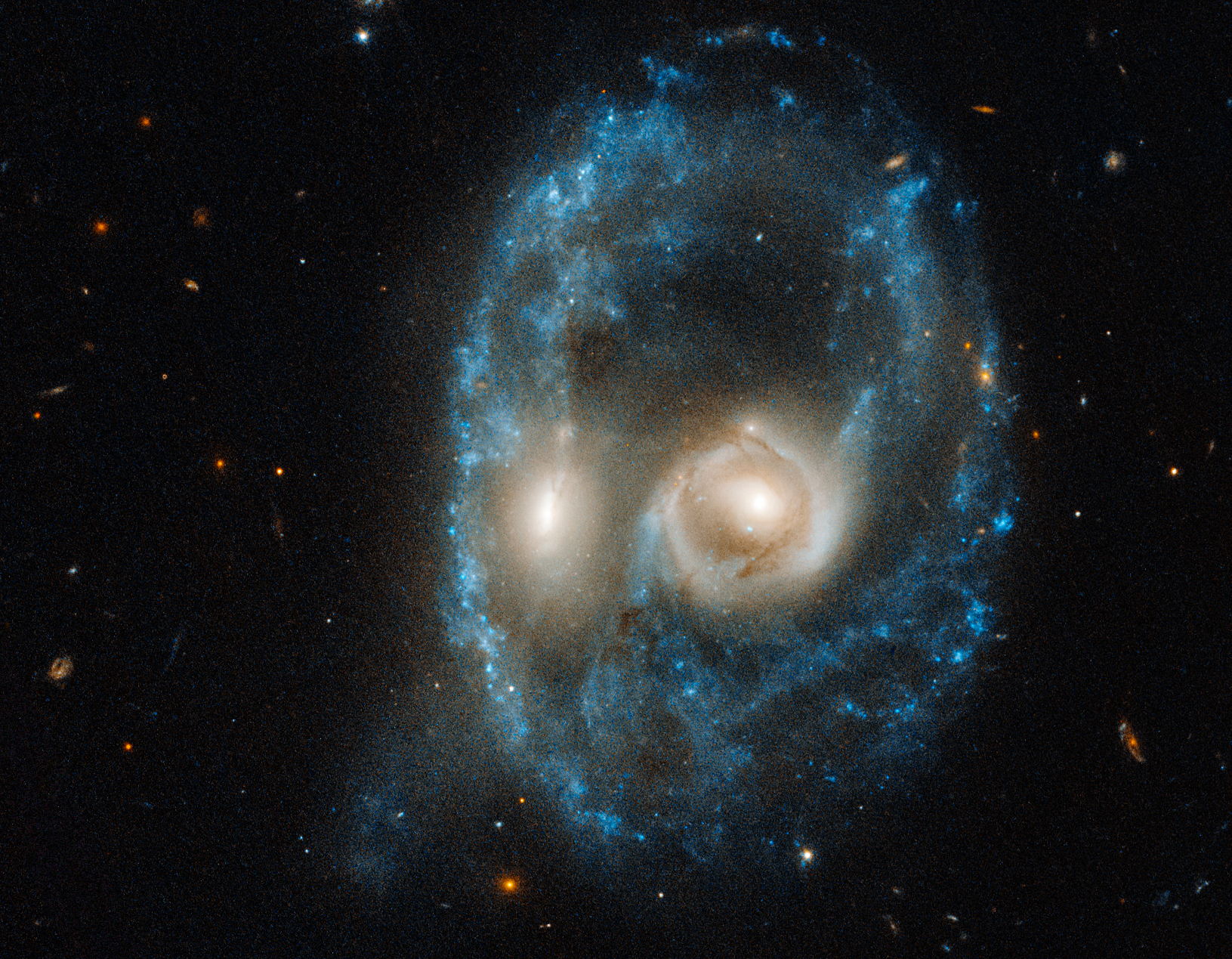Colliding Galaxies Form Piercing Eyes of 'Ghost Face’ in New Hubble Telescope Image
A ghastly face with glowing eyes glares in deep space in a new image from the Hubble Space Telescope.
The piercing "eyes" of this creepy space face are the bright cores of two distant galaxies in the middle of a head-on collision, and they're surrounded by a mishmash of stars from their respective galactic disks.
A ring of young blue stars contours the shape of the eerie face, while dense clumps of stars have come together to form its nose and mouth.
Video: See a Creepy New Hubble Image Just in Time for Halloween
Related: These Scary Things in Space Will Haunt Your Dreams

This spooky mug won't be staring off into space forever. The ring structure that outlines the face will last for only about 100 million years, while the merging of the two galaxies is expected to take about 1 billion to 2 billion years, NASA officials said in a statement.
While galaxy collisions are quite common in the universe, head-on collisions like this one are relatively rare, and the particularly violent nature of this type of collision gives rise to the peculiar ring shape. "The galaxies have to collide at just the right orientation to create the ring," NASA officials said. "The crash pulled and stretched the galaxies' disks of gas, dust, and stars outward. This action formed the ring of intense star formation that shapes the nose and face."
But that rare galactic ring isn't the only thing that makes this pair of merging galaxies special. While most galaxy collisions involve a larger galaxy gobbling up a smaller neighbor — even our own Milky Way galaxy is guilty of galactic cannibalism — the two galaxies merging here appear to be roughly the same size. In other words, there aren't many pairs of symmetric "eyeballs" ogling through the cosmos.
Sign up for the Live Science daily newsletter now
Get the world’s most fascinating discoveries delivered straight to your inbox.
Video: Zoom into Creepy-Looking Twin Galaxies for Halloween
This galaxy merger is known as Arp-Madore 2026-424, a designation that combines the names of the two astronomers that described it in their book "A Catalogue of Southern Peculiar Galaxies and Associations" (Cambridge University Press, 1987), Halton Arp and Barry Madore. Arp-Madore 2026-424 is about 704 million light-years away from Earth in the constellation Microscopium.
Hubble scientists captured this image on June 19 as part of a "snapshot" program that's investigating unusual interacting galaxies. These observations will help NASA choose targets for its James Webb Space Telescope, Hubble's successor, which is scheduled to launch in 2021.
- Haunting Photos: The Spookiest Nebulas in Space
- This Double-Ringed Galaxy Is One of the Rarest Types Ever Seen
- Galaxy Punches Through Neighbor to Spawn Giant Ring of Black Holes
Email Hanneke Weitering at hweitering@space.com or follow her @hannekescience. Follow us on Twitter @Spacedotcom and on Facebook.

Hanneke Weitering is an editor at Liv Science's sister site Space.com with 10 years of experience in science journalism. She has previously written for Scholastic Classroom Magazines, MedPage Today and The Joint Institute for Computational Sciences at Oak Ridge National Laboratory. After studying physics at the University of Tennessee in her hometown of Knoxville, she earned her graduate degree in Science, Health and Environmental Reporting (SHERP) from New York University. Hanneke joined the Space.com team in 2016 as a staff writer and producer, covering topics including spaceflight and astronomy.











